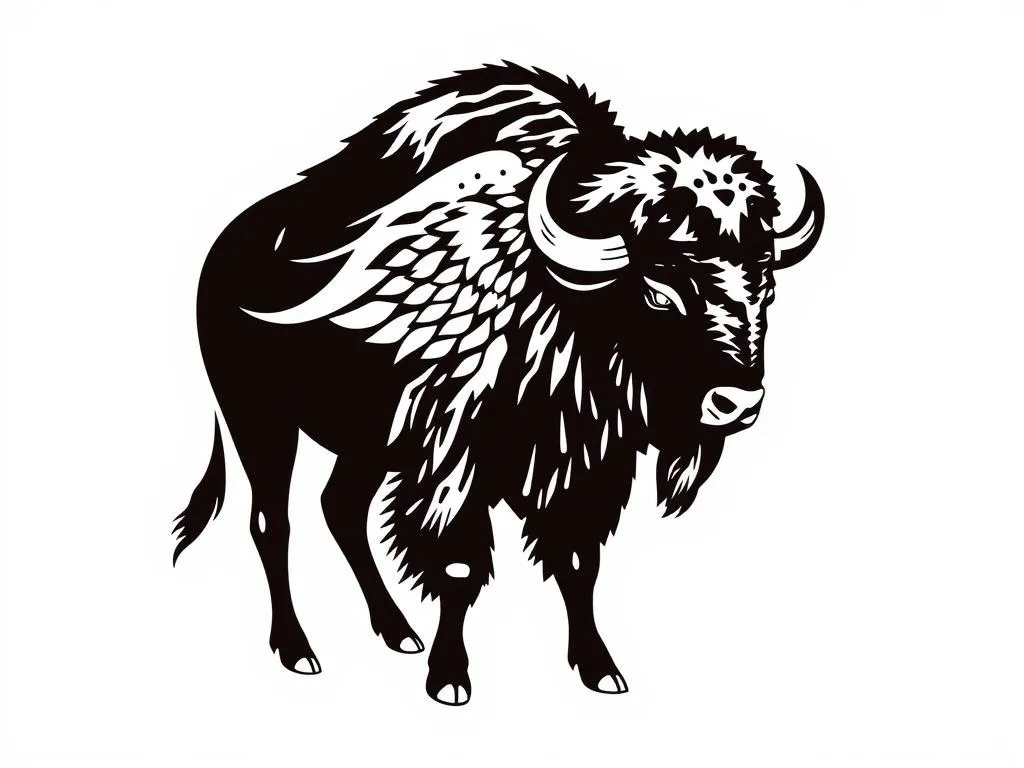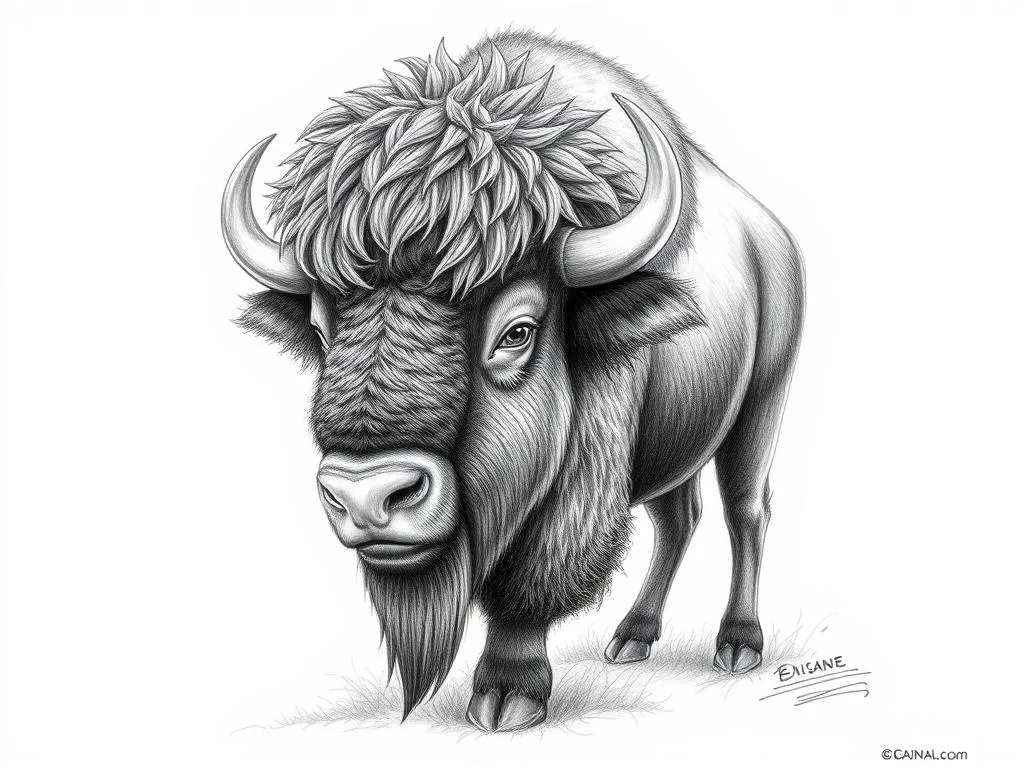The Profound Symbolism of Bison: Guardians of Nature and Spirit

Disclaimer: Some images on this website are AI-generated artworks and may not accurately represent real animals.
Bison hold a unique place in the tapestry of nature and culture, embodying profound bison symbolism and meaning that resonates deeply with many. These majestic creatures, often referred to as buffalo, are not merely animals; they symbolize strength, resilience, and a profound connection to the earth. In this exploration, we will delve into the various aspects of bison, from their physical characteristics to their spiritual significance and modern interpretations.
Understanding the Bison
Physical Characteristics
Bison are among the largest land mammals in North America, revered for their size and strength. Below is a summary of their key physical traits.
| Characteristic | Description |
|---|---|
| Height | 5 to 6.5 feet at the shoulder |
| Weight | 1,000 to 2,200 pounds |
| Lifespan | 15 to 25 years |
| Habitat | Grasslands, plains, and forests |
| Diet | Herbivorous; primarily grass and shrubs |
| Color | Dark brown with shaggy fur |
Bison are well-adapted to their environments, showcasing a robust physique that enables them to thrive in various habitats. Their thick fur provides insulation against cold temperatures, while their massive heads and strong legs allow them to traverse challenging terrains.
Cultural Significance
From the Great Plains to the Arctic tundra, bison have held immense cultural significance for various indigenous peoples, particularly Native American tribes. These animals were not only a source of sustenance but also represented a spiritual connection to the land.
The bison served as a lifeline for many communities, providing meat, hides, and bones for tools and shelter. Rituals and ceremonies often revolved around the bison, symbolizing gratitude and respect for the natural world. Moreover, the bison’s spirit is frequently invoked in storytelling and mythology, emphasizing its role as a protector and provider.
Ecological Importance
As a keystone species, bison play a pivotal role in maintaining the health of their ecosystems. Their grazing habits promote biodiversity by encouraging the growth of various plant species. Their movement across the land aerates the soil, which enhances nutrient cycling and water infiltration.
Additionally, bison impact the habitats of other species. Their presence can create opportunities for smaller mammals and birds, fostering a rich tapestry of life in their wake. This interdependence is a testament to the intricate balance of nature, where each species contributes to the overall health of the ecosystem.

Symbolism & Spiritual Meaning
Strength and Resilience
The bison symbolizes physical and emotional strength, often embodying the virtues of perseverance and resilience. In many cultures, the bison is seen as a powerful protector, guiding individuals through life’s challenges. This symbolism is particularly resonant for those facing adversity, serving as a reminder of the inner strength that lies within.
Connection to Earth
A profound aspect of bison symbolism and meaning is their connection to the earth. Bison are often viewed as guardians of nature, representing a grounding force that reminds us of our relationship with the natural world. Their presence encourages individuals to reconnect with the earth, fostering a sense of belonging and harmony.
Abundance and Prosperity
Historically, the bison represented abundance and prosperity, particularly for indigenous communities reliant on these animals for survival. The bison’s role as a vital resource underscores its significance in cultural narratives about sustenance and well-being. As a symbol of plenty, the bison encourages gratitude for the resources provided by nature.
Community and Family
Bison are social animals that live in herds, showcasing a strong sense of community and cooperation. The social structure within bison herds emphasizes unity and familial bonds. This aspect resonates with the idea that strength is found in community, serving as a reminder of the importance of relationships and support systems in our lives.
Bison in Dreams
Interpretation of Bison Dreams
Dreaming of bison can evoke various emotions and meanings, often linked to their symbolic traits. Below are some common themes associated with dreaming about bison.
| Dream Theme | Meaning |
|---|---|
| Strength | A call to embrace personal power and resilience |
| Connection | A reminder to ground oneself and reconnect with nature |
| Abundance | Signals of prosperity and abundance in life |
| Community | Emphasizes the importance of family and social bonds |
| Protection | A sign of spiritual guidance and support |
Messages of Guidance
Seeing a bison in dreams may signify important messages regarding personal growth and challenges. It can serve as a reminder to harness one’s strength when facing adversities, encouraging the dreamer to confront obstacles with courage.
Moreover, such dreams can highlight the need to reconnect with one’s roots and establish a deeper connection to nature. This connection may lead to a sense of peace and clarity in one’s life.
Cultural Context
Different cultures have varied interpretations of bison in dreams. In Native American traditions, dreaming of a bison may symbolize a call to honor one’s ancestors and respect the natural world. Such dreams are often seen as spiritual messages, guiding individuals on their journeys.
In contrast, some contemporary interpretations may view bison in dreams as a representation of personal empowerment and resilience. This diverse symbolism illustrates the bison’s enduring relevance in both traditional and modern contexts.
Modern Interpretations
Bison in Popular Culture
The representation of bison in art, literature, and media reflects their symbolic significance. Bison often appear in works that explore themes of nature, strength, and community. From paintings to novels, these majestic creatures inspire creativity and evoke admiration.
In contemporary culture, bison are also featured in logos and branding, symbolizing ruggedness, endurance, and American heritage. This usage reinforces the bison’s status as an icon of strength and resilience.
Conservation Symbols
In recent decades, bison have become powerful symbols of wildlife conservation efforts. As populations dwindled in the late 19th century, conservation initiatives aimed to restore bison to their native habitats. These efforts have not only helped to stabilize bison populations but have also highlighted the importance of preserving biodiversity and protecting ecosystems.
The bison’s recovery is a testament to the resilience of nature and serves as an inspiration for conservation efforts worldwide. Bison are now celebrated in various campaigns, representing hope for the future of wildlife conservation.
Spiritual Practices
The use of bison in contemporary spiritual practices and rituals reflects their enduring significance. Many people incorporate bison symbolism into their spiritual journeys, using it as a source of inspiration and strength.
Rituals honoring the bison often involve offerings and prayers, emphasizing gratitude for the gifts of nature. This practice fosters a sense of connection to the earth and a deeper understanding of one’s place within the natural world.
Key Takeaways
- Cultural Reverence: Understanding the historical significance of bison among various cultures is essential for appreciating their role in human history.
- Personal Reflection: The symbolism of bison can inspire personal strength and resilience, encouraging individuals to confront challenges with courage.
- Conservation Awareness: Preserving bison populations and their habitats is crucial for maintaining ecological balance and biodiversity.
Conclusion
The bison’s enduring legacy is a multifaceted tapestry of bison symbolism and meaning that resonates across cultures and time. As guardians of nature and spirit, bison remind us of the strength found in resilience, community, and connection to the earth. Their significance in cultural narratives, dreams, and modern interpretations underscores the importance of honoring these majestic creatures and the ecosystems they inhabit.
By exploring our connections to nature and recognizing the role of bison in cultural and ecological contexts, we can foster a deeper appreciation for the world around us. Embracing the lessons imparted by these magnificent animals can inspire us to embody their strength and resilience in our own lives.







